Today, I am reviewing a Sakshama Branford Marsalis model Delrin tenor saxophone mouthpiece that I bought used online because I was curious about this tenor sax mouthpiece. I have read that Branford Marsalis played a Guardala tenor sax mouthpiece in the 80’s and 90’s (not sure when he switched to something else) and I have always been curious about what kind of baffle and chamber Branford’s Guardala tenor mouthpiece had in it.
Sakshama Branford Marsalis Delrin Tenor Saxophone Mouthpiece
I found this quote describing the original Guardala Branford Marsalis mouthpiece on the Dave Guardala handout flyer from 1990:
Guardala Branford Marsalis Model:
This is an exact replica of the mouthpiece played by Branford Marsalis. It has a large bore and chamber and a moderate baffle. It is perfect for playing mainstream jazz with the “harder” sound Branford is known for.
The Sakshama Branford Marsalis model tenor saxophone mouthpiece is made of Delrin which is a polyoxymethylene thermoplastic. From what I can gather from google, Delrin is a plastic that has been cleared as food safe by the FDA. I have also read that it is a very tough and stable material.
The Sakshama Branford Marsalis tenor saxophone mouthpiece is a .110 tip opening which is an 8 tip opening. It has a slim profile tenor sax mouthpiece diameter and shape to it similar to a metal Guardala tenor saxophone mouthpiece although I think the Sakshama might be slightly thinner.
The beak of the mouthpiece is thin and has a duckbill feel and shape to it. I personally do not like the thin duckbill type beak profile on the sax mouthpieces I have tried. This mouthpiece beak feels thinner than a typical Guardala saxophone mouthpiece thickness to me (although it has been years since I played a Guardala mouthpiece). I found that adding a thicker bite patch to the mouthpiece made it feel more comfortable for my tastes.
Sakshama Branford Marsalis Delrin Tenor Saxophone Mouthpiece
As soon as I received the Sakshama Branford Marsalis mouthpiece I sent Sakshama a few emails to ask questions about it. My first thought and question when looking at the mouthpiece was “Is this an exact copy of a Branford Marsalis Guardala mouthpiece?” Here are some quotes I received back from Sakshama in a few emails:
- It is not an exact copy of a Branford Guardala but inspired by a Guardala mouthpiece. Knowing how the 100th part of an inch affects the sound, I can’t claim it is identical. They are CNC machined with my hand facing and baffle work. I have the same G line (Guardala) CNC machined in bronze and the Delrin line in black and white color. I make all the Guardala models, starting from Crescent to King in Delrin and bronze. I play test them against an excellent handmade Guardala I have and they have to perform on the same level to ship.
- I have seen all the Guardala pieces and measured them so that I can reproduce them. Still, the tip opening can be very misleading. A .118 tip opening Branford model will look different than a .110 tip opening if the attempt is to make them play similarly. So it is not an exact science but more of a sound search.
- I spend a lot of time weeding out from the baffle the unpleasant particles of the sound. You hear my preferences and sensibility in the tonal picture presented, something totally mine, not Guardala or anybody else. Evolution as a mouthpiece maker and a listener.
-
It wasn’t my intention to make something identical to Guardala mouthpieces. I’m sure the dimensions will differ. Even when the blank is identical that doesn’t guarantee the same performance as Guardala. Far from it. The facing and especially the baffle work is where all the marbles are in making a good saxophone mouthpiece and I like to be judged for that. Since the beginning of saxophone, there are few mouthpiece concepts that work, the Guardala concept being one of them. Sakshama
To sum up Sakshama’s thoughts in my own words, the Sakshama Branford Marsalis model is inspired by the original but when creating different tip openings like this .110 tip opening, certain adjustments were made to get the best tone and response from the mouthpiece according to Sakshama’s tastes.
Sakshama Branford Marsalis Delrin Tenor Saxophone Mouthpiece
The tip, rails and table of the Sakshama Branford mouthpiece look relatively even and well crafted. The shape of the mouthpiece tip rail is an exact match to the shape of the BSS (Boston Saxophone Shop) saxophone reeds I used on it. The side rails and tip rail are Guardalaesque in their precise thinness.
I have to say, that the height of the baffle of the Sakshama Branford Marsalis model tenor sax mouthpiece was a surprise to me. It has a flat high baffle that is about a half an inch long that then rolls over smoothly and slants down to the entrance of the chamber. The bottom of the downward slope is scooped out to make the chamber area slightly bigger. The baffle does look similar to the original Guardala Branford Marsalis mouthpiece photos I have posted below in height and length to my eye except the Sakshama seems to have a bit of a smoother roundness to the edge of the baffle where it changes direction after half an inch from what I can see.
I compared the baffle height and shape to some other higher baffled mouthpieces I have like the Liu Shizhao Pilgrimage (copy of a Guardala that Michael Brecker reportedly had) and this Branford Marsalis mouthpiece has a higher baffle than the Pilgrimage for that first half inch of baffle.
Although the original Guardala Branford Marsalis description I posted above describes the mouthpiece as having a large chamber and bore, the opening to the chamber on the Sakshama looks to be a medium size chamber to me. The raised baffle floor at the entrance to the chamber and the straight sidewalls make it seem a bit smaller than a typical metal Otto Link chamber entrance.
The sidewalls are straight until they get to the chamber where they are carved out slightly to round out the chamber a bit. The roof of the chamber is close to the table of the mouthpiece and is nice and thin also.
Sakshama Branford Marsalis Delrin Tenor Saxophone Mouthpiece
Original Guardala Branford Marsalis Mouthpiece Photo Found Online
Another Original Guardala Branford Marsalis Mouthpiece Baffle Photo found Online
The Delrin material of the Branford Marsalis saxophone mouthpiece has a smooth feel to the touch and the mouthpiece is very light in weight. I didn’t want to take the chance that my teeth might mark up the beak so I put a Forestone black mouthpiece patch on the mouthpiece but the Forestone patch fell off pretty quickly. I think the fact that the Delrin has an oily feel to it coupled with the curve of the beak made it harder for the Forestone patch to cling to. This leads me to my next huge revelation……..
Huge Revelation
I have been reviewing saxophone mouthpieces for about 15 years now and I discovered something new on this review! When I received the Sakshama Branford Marsalis mouthpiece, I put a black Forestone mouthpiece patch on it (mouthpiece patches are a cushioned patch that go on the mouthpiece beak and protect the mouthpiece from your teeth while also making playing more comfortable) and took my saxophone out to a barn near my house to test it out. The first clip below is from that excursion.
I was awestruck by how well the Sakshama Branford Marsalis mouthpiece played. It had loads of power and was just smoking from top to bottom in my opinion. Near the end of my session, the mouthpiece patch fell off and so I wrapped up my playing in the barn and came back to my house excited about this new tenor sax mouthpiece.
The next day, I put a thinner clear 3M patch on the Sakshama Branford Marsalis mouthpiece (because the Forestone patch would not stay on) and tried playing in my house. I absolutely hated it! It was horrible! Way too loud and edgy. The tone was thin, piercing and honestly was painful to my brain. I was dumbfounded! I tried reed after reed but had no luck at all. At the end of that session, I just assumed that I had found the perfect reed in the barn and that this mouthpiece wasn’t that great after all.
Months later, I decided to give the Sakshama Branford Marsalis tenor mouthpiece one more shot. On a whim, I decided to try another Forestone black patch on it over the 3M clear patch that was already on it just because the thinner beak of the mouthpiece didn’t feel comfortable to me and the black patch would make it a little thicker.
The mouthpiece played great again! Thick and full sound that was focused and powerful but not overly bright and annoyingly edgy. I had found a great reed again, I thought. Yeah!!
I recorded the second sound clip below with that reed and the mouthpiece played incredibly well. But here is where I had the “aha” moment! Towards the end of my second clip, the Forestone mouthpiece patch fell off again! I threw it on my desk and attempted to keep playing. Now, however, I couldn’t stand the way the mouthpiece played again! It was too loud, edgy and thin sounding. It was the same reed and nothing had changed except that the thicker patch had fallen off.
That is when I realized that what I was hearing and so disgusted with, was not the sound of the mouthpiece coming out of my sax but the sound of the mouthpiece coming “through” my head. The vibrations and sound were coming through the Delrin, through the thin clear patch, through my teeth and right into my ears or brain or whatever. I was amazed! Could a mouthpiece patch make such a difference in sound to me?
I have known that a mouthpiece patch can make a difference with how a mouthpiece sounds to the player but I have never experienced such a drastic change of perception.
As a test, I continued to play on the mouthpiece without the thicker black mouthpiece patch for a few minutes as painful as it was for me. I then put a fresh Forestone patch on and played again for a few minutes and was again happy with the sound and tone.
Afterwards, I listened back to the sound clip and guess what? I could hear no difference whatsoever in the recording. I knew exactly where the patch fell off, and where I put one back on, and I could not hear any difference whatsoever! This blew my mind! I’m still amazed by this as I type this out! Wow!
Sakshama Branford Marsalis Delrin Tenor Saxophone Mouthpiece
The Sakshama Branford Marsalis model tenor mouthpiece played great with BSS (Boston Sax Shop) size 2 1/2 reeds. It played so well, that I didn’t even try other reeds on it. Both clips below were made with two different BSS 2 1/2 reeds. The two clips were recorded months apart as I recorded the first barn recording 2-3 months ago when I first got the mouthpiece in the mail.
The Sakshama Branford Marsalis model tenor mouthpiece has a focused tenor sax tone that definitely leans to the bright side of the tenor saxophone tone spectrum to me. The more you push the mouthpiece, the brighter it would get for me.
Even though it was brighter, I still found the tone thick enough to pull off some jazz lines and play some jazz standards. It was not as bright as a Guardala Studio model I used to have that is for sure. When pushed the Sakshama Branford Marsalis model could go into pure “Brecker” mode in my opinion. Maybe not early Brecker Brothers brightness but I could get pretty close.
Sakshama Branford Marsalis Delrin Tenor Saxophone Mouthpiece
This is also, without a doubt, one of the loudest tenor sax mouthpieces I have played. It could take all the air I could give it and go to like a 13 on the volume scale. I have probably said that about every Guardala mouthpiece I have played, so this Sakshama Branford Marsalis mouthpiece is similar in that regard. (I think the Guardala Super King I tried out years ago has the volume record for me……)
The intonation was very good! My Selmer SBA tenor saxophone (from the 50’s) can tend to be a bit sharp on certain notes with high baffled mouthpieces but the Sakshama Branford Marsalis model tenor mouthpiece was very easy to play in tune throughout the range of the horn.
The evenness of notes throughout the range of the saxophone was nice and smooth when playing fast lines also. The character and thickness of tone seemed to blend well as I played faster lines throughout the range of the saxophone.
The altissimo register was also easy to produce on the Sakshama Branford Marsalis mouthpiece and the notes were easy to control and manipulate. This mouthpiece can really go all out in the upper register and get a pretty gritty raw sound if you choose to go in that direction.
Sakshama Branford Marsalis Delrin Tenor Saxophone Mouthpiece
On the two sound clips below, I try to give a good range and variety of sounds and textures so that you can hear the Sakshama Branford Marsalis tenor saxophone mouthpiece perform in different styles.
The first clip in the barn was as much a test of the recording environment as anything else. I knew it would have an incredible echo and reverb as I was playing in the basement of the barn and the walls were all concrete with about 10 open concrete rooms that were mostly empty. You can hear the natural reverb in the clip.
The second clip is in my office and in an acoustically dry environment with no reverb or effects whatsoever. I wanted to provide this clip, as well as the barn recording, to give you an idea of how this mouthpiece plays in both environments. When I hear guys on Youtube making mouthpiece clips in big rooms with lots of reverb, it can be really deceptive as the sound of almost any sax mouthpiece will sound pretty killer in those rooms with a natural reverb to them.
Sakshama Branford Marsalis Delrin Tenor Saxophone Mouthpiece
One thing I want to address before I wrap up this review is that I know that I sound nothing like Branford Marsalis on these sound clips. The fact is, that even though I have listened to many of his recordings, I have never immersed myself in them or tried to sound like him. His sound and phrasing is not in my brain or ear, so a mouthpiece by itself will not transport me magically to that sound and phrasing.
I believe that Branford’s embouchure approach is very different from mine also. I have heard that he uses a double lip embouchure and from photos I have seen I think this is probably true although I haven’t done research on this and don’t know for a fact. I certainly get a much brighter tone out of this mouthpiece than I hear from his early recording with his Guardala but I can imagine how a harder reed, more bottom lip on the reed and differences in our physiology could make a huge difference in tone between two people.
Branford Marsalis Playing the Tenor Sax (Double Lip Embouchure?)
In my opinion, the Sakshama Branford Marsalis tenor saxophone mouthpiece is a great mouthpiece for those of you looking for a tenor mouthpiece with a tone that is bright and powerful enough to do the “Brecker” concept and sound but isn’t as bright as a Guardala Studio or Super King would be. I have owned a few versions of both of those latter saxophone mouthpieces and always had a hard time playing jazz standards on gigs. They just didn’t give me the depth and warmth of tone I was looking for for jazz playing in my opinion.
The Sakshama Branford Marsalis mouthpiece keeps the Brecker brightness but leans a bit more towards the middle so you can produce a warmer sound for jazz. Don’t get me wrong, this is nothing like an Otto Link but it does head a little bit in that direction which is what a lot of tenor players are looking for. I think Sakshama Koloski at Sakshama mouthpieces has done a great job with this Sakshama Branford Marsalis tenor saxophone mouthpiece. If you are interested in trying out this model or one of his other handmade mouthpieces you can contact him on his site. He makes his own versions of the Guardala Crescent, Branford, Brecker 1 and 2, Studio and King as well as many other models of saxophone mouthpieces.
If you try a Sakshama Branford Marsalis model tenor sax mouthpiece or have any thoughts or comments on this review, I would love to hear what you think in the comments below. Thanks, Steve
Sakshama Branford Marsalis Model Delrin Tenor Saxophone Mouthpiece Recorded in Big Barn near my House-BSS (Boston Sax Shop) 2 1/2 Reed-A lot of Natural Reverb from the Barn
Sakshama Branford Marsalis Model Delrin Tenor Saxophone Mouthpiece Recorded Dry in my Office with no effects-BSS (Boston Sax Shop) 2 1/2 Reed
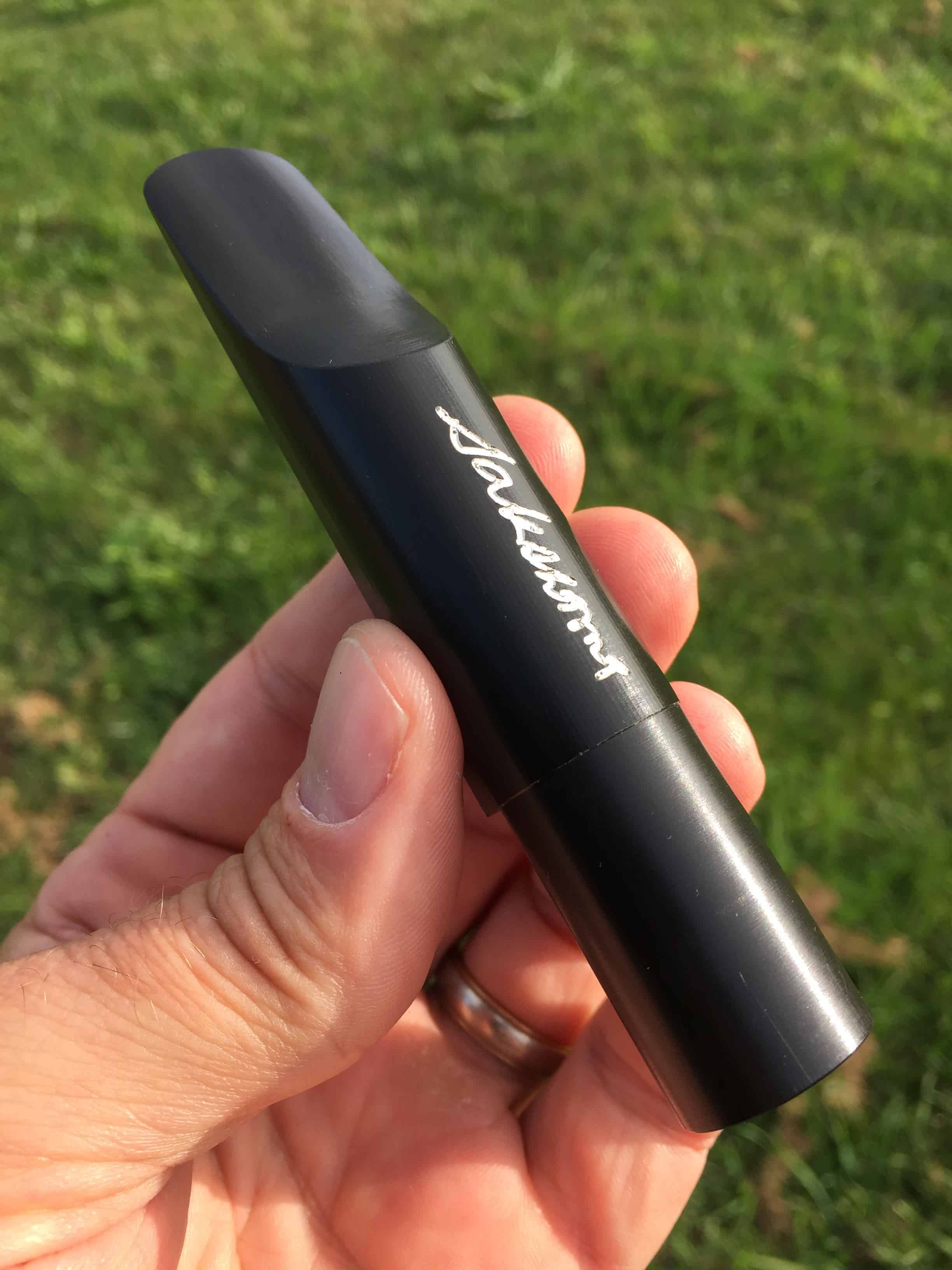


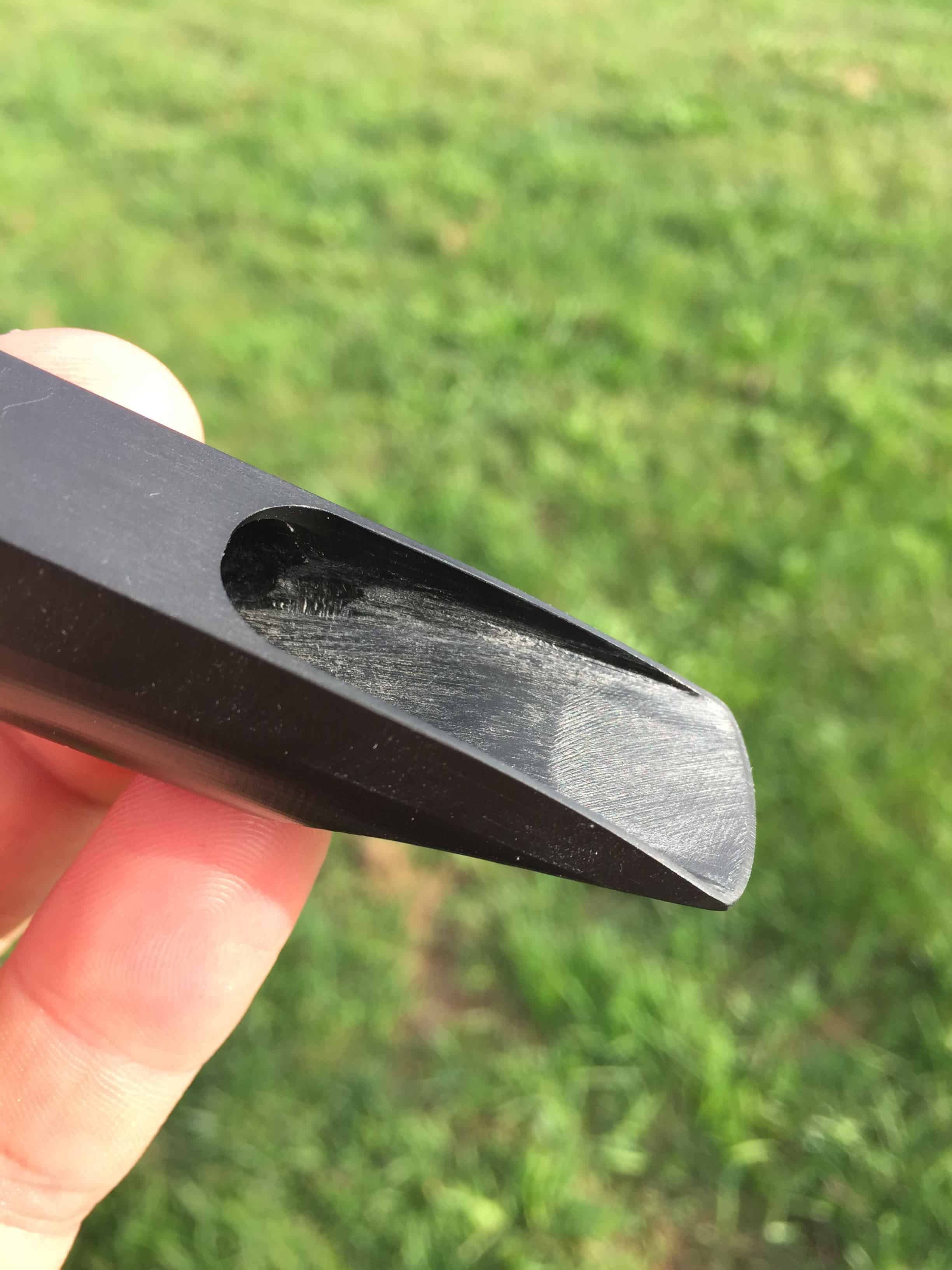
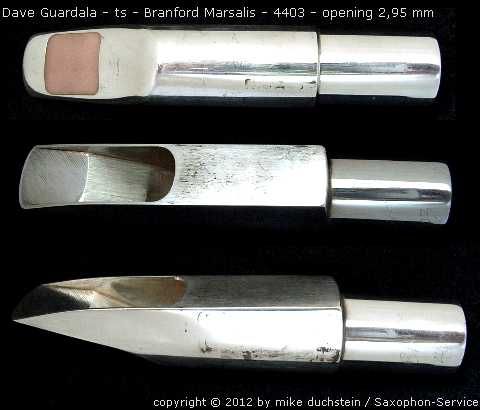

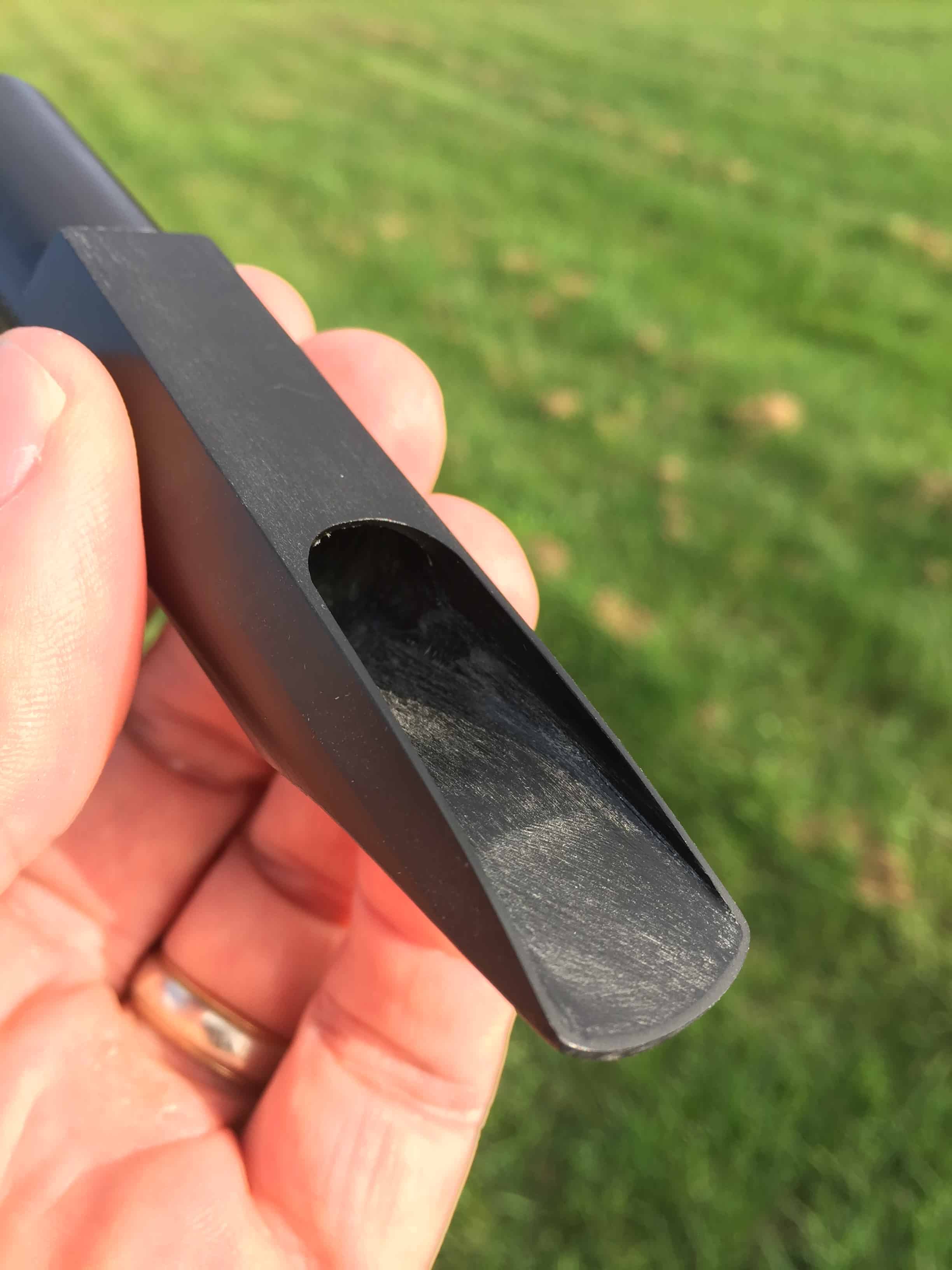
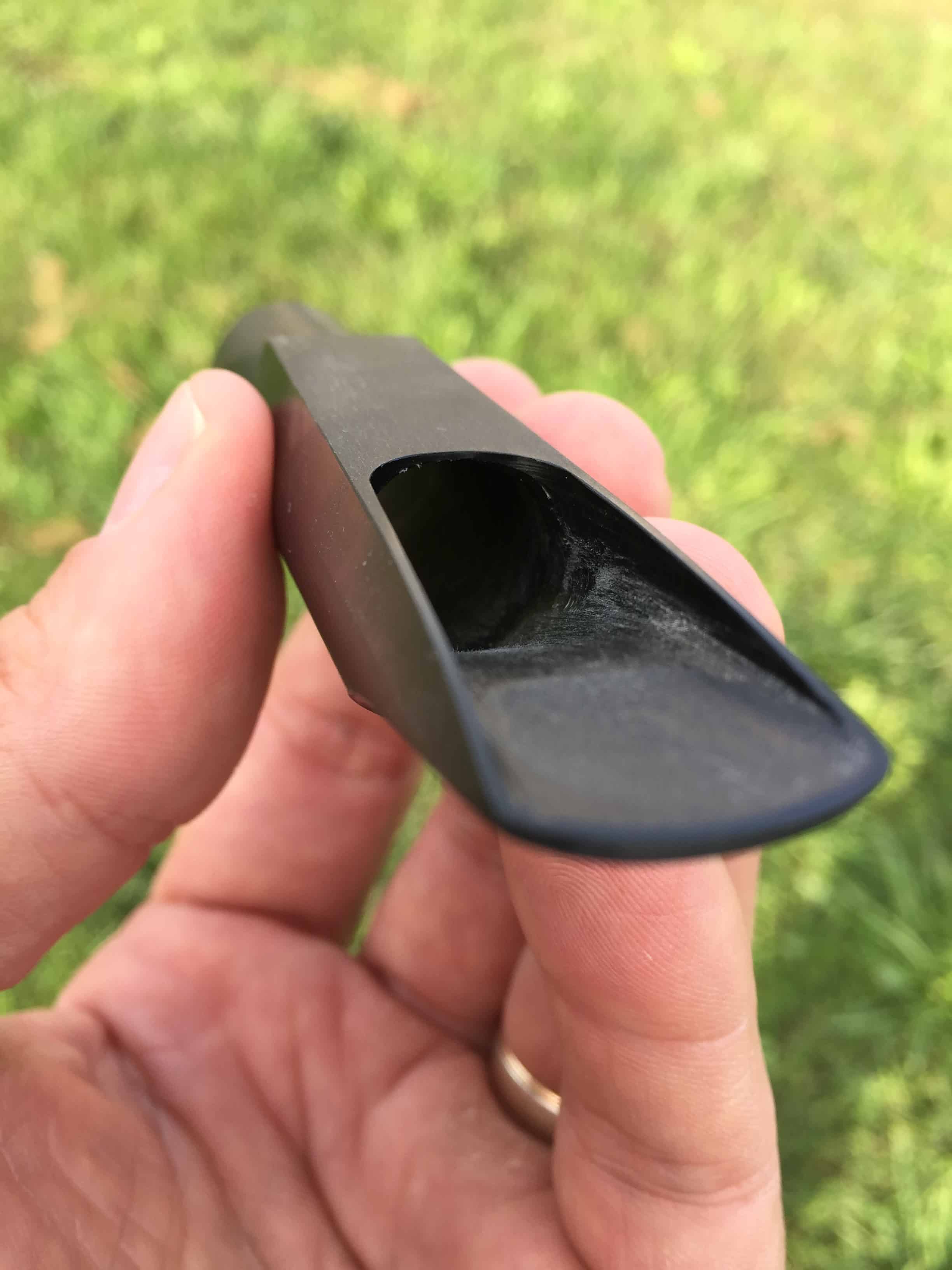
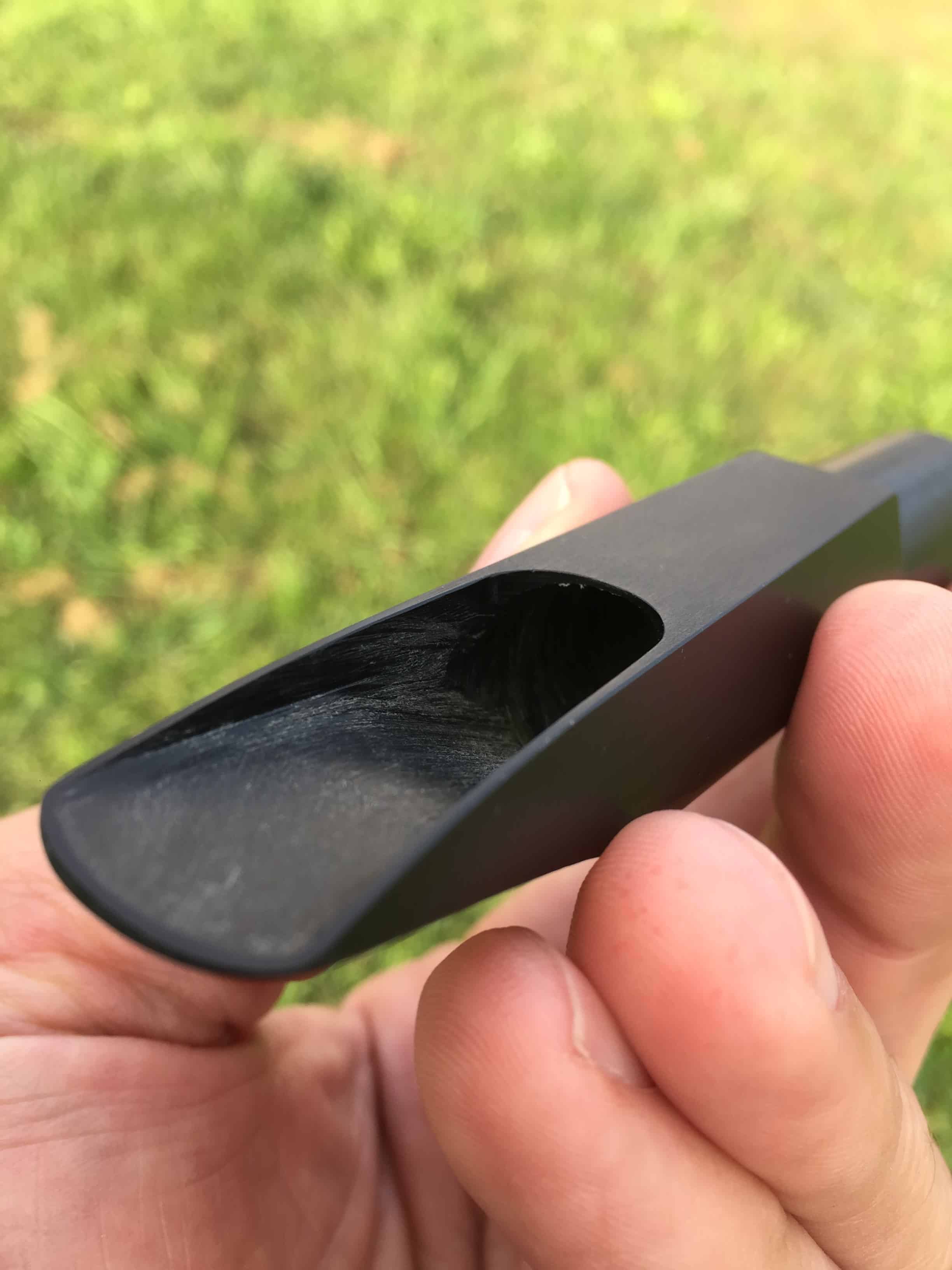
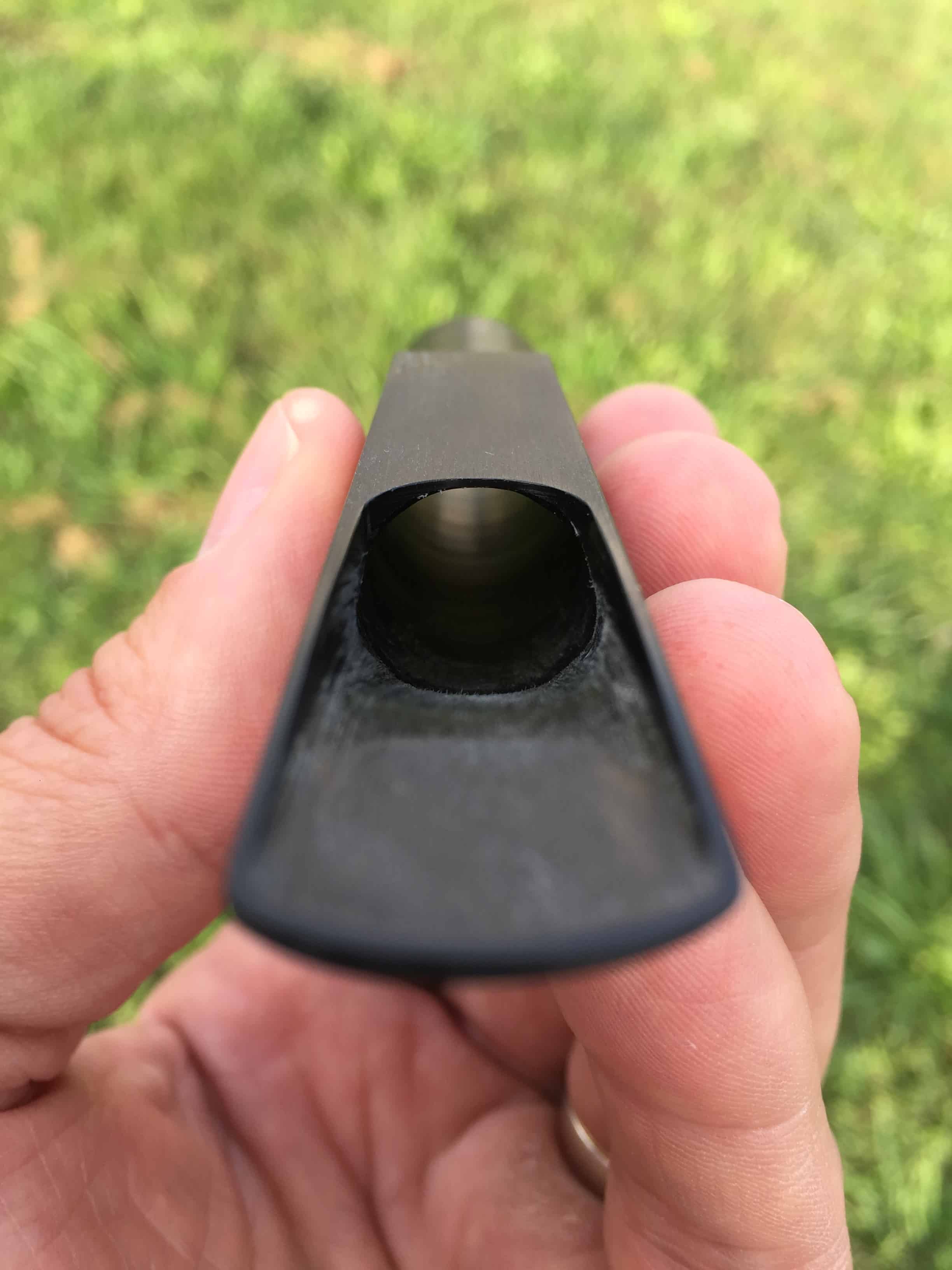




Hi Steve,
Here Tobias from Forestone (if you remember, you got the bite patches from me ? ).
Nice to hear that our patches are also the best sounding ones ?
But seriously, the solid bore sound is a huge aspect of what we perceive as players. Personally I hate all plastic mouthpieces and metal is too bright for me. I don’t think that the material itself has such a big effect on the sound itself but a big effect on how we hear ourselves.
But how we hear ourselves has an effect on how we play. If we hear ourself too bright we adjust for a darker sound.
Some years ago, my teacher asked me for my opinion of two Lakey mouthpieces. I heard the first one brighter than the second. He heard it the other way around. The answer was, on one mouthpiece was a thicker bite plate….
About the not holding patches, since they are self adhesive, it’s important what the other surface is. On very smooth ones (mostly direct on metal) water can get under the patch. And once “the pores” of the patch are dirty, it won’t stick any more.
I hope this helps.
Liebe Grüße aus Deutschland
Tobias
Hi Tobias,
Great to hear from you. I have still been using all of those Forestone patches I bought from you years ago. I was actually thinking today that I am running low and should order more. They work great on the majority of mouthpieces and are easy to take off and put on another mouthpiece which makes them so great for a mouthpiece reviewer obviously. I have had some instances with Delrin and some other materials where they didn’t stick but on hard rubber they have been amazing for me. I’ll let you know if I need some more by email…….Thanks, Steve
Sounds great! Nice playing of course. I could not find this model on their website. Has it been discontinued?
If you are interested in trying out this model or one of his other handmade mouthpieces you can contact him on his site. He makes his own versions of the Guardala Crescent, Branford, Brecker 1 and 2, Studio and King as well as many other models of saxophone mouthpieces. I put a link towards the end of the article.
Considering the height of the baffle near the tip, it’s surprisingly full bodied and wonderfully clear. Love the sound in the barn.
Nothing makes you sound as good as playing in a big barn!! Wish it had heat. I would be playing in there all winter……. haha!
Interesting review as always, with lots of detailed information. Thanks! I know there has been a lot of discussion about how materials affect the sound: do you know of any HR or Delrin mouthpieces that have the same projection, timbre, and volume as metal ones? I’m interested because my current gigs require a loud and bright sound, but I find metal MPs less comfortable, even with a cushiony patch.
The Branford Marsalis model is under my Sakshama G line, either in delrin or bronze. Probably I should separate them but now 6 different models are under the G line: Crescent, Branford Marsalis, Michael Brecker, MBII, Studio, and the King. Anyway, the ordering requires some communication as I’m making every mouthpiece by hand according to the player’s needs so there is no “buy it now” button.
Sakshama
I wonder why don’t you 3dprint your CAD models from Delrin filament?
I have printed some prototypes on my 3dprinter. Yes hand facing is required too. But mostly only for print line smoothing.
Next, there is a problem with thin walls of plastic slim mps – “nasal” sound. I believe that is why f.e. SYOS makes classic form – thicker walls.
Yuri
Hi Yuri, Short answer is I’m a craftsman and not a tech guy. For 3D printing, I need to make ticker walls mouthpieces as it is not working with delrin and I need completely new designs. I’m not doing programming myself but have a technician doing it. My G models took very long time with many corrections and I don’t see myself going through it again with 3D printing without an obvious advantage beside the cheaper process. I have several other CNC models in the process that are slow to come.
The best I’ve ever heard you sound! I’ve been a Guardala player since ’89 and it sounds like Sakshama has captured many of the secrets to them. One thing that characterizes any model of Guardala and apparently a well-made tribute piece is that seemingly infinite headroom as you mentioned, where when you hit the gas, it just goes with you instead of breaking up. I have been thinking of getting one of his .112 MB Delrins. My current piece is a ‘King Curtis’ .116 which I’m not thinking of abandoning but I would like somewhat less of a ‘flamethrower’ sometimes. Thanks for the review and it definitely helped make up my mind!
Thanks to Willie for asking about info on how to obtain one. That was not clear on the website. And thanks to Sakshama for mentioning the need for direct contact. Great piece!
Hi Steve,
I agree great sound. As I like to term it, “out in front”.
About the Forestone mpc patch; I’ve used a number of patches on Delrin mpcs for years and they don’t fall off. I have to rub the glue off with my thumb like any other mpc. I really like the patches Erik Griefenhagen or Mojo use as both of those clear pieces are nice.
I wanted to go see Sakshama when he was out on Long Island, but traffic from NJ was a bit scary, so I abandoned the idea. Good luck,
Ted
I would like to give a different approach to the discussion:
As for your own voice, you hear your sound through the bones of your head “and” through the air.
This explain why you feel your recorded voice “strange”. You hear the recorded voice only through the air.
Just the same applies to the saxophone. You hear it through the headbones and through the air.
Loved the clips. Sakshama is an absolute master craftsman. Steve, your site is my go to source for mpc info.
Dave. aka saxcop
That barn has some darn nice reverb. Warm with reasonable decay.
One other contribution to the “in your head” mouthpiece sound challenges we face. I have had sinus issues all my life to varying degrees. I believe this is also a huge part of what we hear in our heads through the mouthpiece/teeth resonance. If anyone has ever tried playing sax with a bad head cold they may have experienced this. With my issues sometimes I have a “flare up” when sinuses are worse but sometimes they are fairly clear. I believe this has led me to have some wildly differing and inconsistent opinions when trying mouthpieces, horns, necks etc. and it’s been a challenge.
And I couldn’t agree with you more about our own sound perception making us play differently. That’s big time! It doesn’t matter that it sounds the same on a recording. This is a point that the “sound/science argument people” always seem to miss. Not only will I make playing adjustments which can change the tone based on what I am perceiving, but this will often change the ideas and moods I spontaneously choose to play. This is a huge and very legitimate issue. Thank you for bringing it up.
Someone on SOTW (Sax on the Web) posted this comment which I thought was really interesting and backs up my experience and thoughts:
“Great review Steve, and quite the revelation too!
I’ve been struggling of late with reeds, finding many end up too edgy and bright for my tastes, so having read your review I immediately did some A-B recording, alternating between the 0.4mm clear BG patch I usually use and then with an 0.9mm black BG patch stuck on top. My experience of playing the thick and thin patch set-up was completely different, no matter which reed I used! And the recordings? To my ears, it was absolutely impossible to tell the difference between the patches – just as you observed.
I perceived more core and focus in the sound when using just the 0.4mm patch, where the sound appeared to have more body and less focus when I added the 0.9mm on top of it. Strangely, all the reeds felt more free-blowing with the thick set-up, something that I am struggling to explain. Just to reiterate: I could not detect any difference at all in the recorded sound, no matter how many times I went back and forth between the patches!
I’m not sure that this has solved my reed issues sadly, but it has been a timely reminder that how I hear my sound when playing really is only part of the story.
Steve, following your revelation have you been tempted to experiment with different patches on your main mouthpiece? I’d be curious to know if you have any further insights.”
Quand on met un patch plus épais on ouvre plus la bouche et le son change à cause du plus grand volume. Les muscles travaillent aussi différemment.
Translation:
When you put a thicker patch you open your mouth more and the sound changes because of the greater volume. Muscles also work differently.
Nice playing and great sound. Sakshama is a wonderful mouthpiece maker. Everything is so full of character when he makes it. I am always amazed at how you get a full thick sound out of those high baffle pieces, Steve.
Steve,
I commented a few days ago about your review of the SYOS Originals soprano Mps and how great the playing was. Anyways, I got this mouthpiece today from Sakshama. I asked for the smallest opening in this model which is a 108. First of all it looks like a slick plastic tubing and it is extremely light. Mine came with a teeth guard already and cut to the profile of the beak and that is glued quite well. Not only is it light – it has thin walls and reminds me a race car or race bike chassis. I am not a stranger to this minimalist design – my most comfortable bike seat is thin carbon shell with no cushioning. Comfortable for 6 hour rides,
I think by using this material and this design, he hones on the basic functions of the mouthpiece. An interface between the oral cavity and the neck, create and shape the air turbulence and support the reed. I do not know how much the material affects the damping or resonance of the reed. Whatever it is – it is a very effective design. I adjusted to it in minutes.
My embouchure is lip out. I also have dental implants and this mouthpiece is a blessing.
When I got it. I was in the middle of balancing old Marca Superieure #3 reeds which are like #3.5 Blue box Vamdorens. I was a Yamaha 4C to play test and break them in. I was so excited that I just put the one reed I was working on not the #3 Java Reds. That reed just played where it was stuffy on an STM 7*. I was really surprised and also tells me that this is a reed friendly mouthpiece with a very flat table and symmetrical side rails.
Tone – It is centered leaning toward dark, not scooped EQ and the edge by default is subtle. Play assertively and you get that hard bop sound. Not sure if you can do smooth jazz on it. The note release it you tongue it is quite short and again because the material does not resonate like metal but no dampening that hard rubber gives. One thing I like is that if you back off your air it can be classical or clarinet sounding on the second register/octave .
Dump a lot of air and intention and you can get into Ayler, David S Ware, Pharoah territory, Like you said a loud mouthpiece. In my small collection of tenor mouthpieces (7), the Vandoren Jumbo Java is the king of volume. It is also fun to play rapid passages on it – it responds well to that kind of playing
Altissmo is easy and multiphonics as well. Intonation is reliable. I am using a V1 neck on a Yamaha 62II. My SDA is in the shop and that SDA sounds like my SBA which needs some work done. I’ll be curious if this piece will accentuate the richness of core tone of those 2 horns
It’s early days but I think Sakshama understood what I want. Even though the Branford model was the starting point he did add something to it based on what I told him, which was open ended and not specific. I do like Branford Marsalis and know some of his albums. When he came here in Santa Fe, Tain Watts rented a drumset from my friend and he told some stories.
Thanks. This review actually convinced to start with this model. I will definitely get at least one more Sakshama creation. This is my first bespoke mouthpiece although I have one Jon Von Wie reface and I bought a few from small makers’ inventories.
Wow! Thanks Noel for the detailed review! This was great to read. I appreciate you taking the time to share your insights with all of us. Steve
Greetings,
Branford’s tenor sound these days is very dark. I first noticed this on his “Upward Spiral” album (2016). The sound on your sound clips with the Sakshama is similar to Branford’s sound on albums from the 80s and 90s, but much brighter than his sound on albums from the last few years. Branford’s FAQ page on his Marsalis Music website says he plays a Lebayle. I wonder whether he is playing the Sakshama these days. I also wonder whether a double lip embouchure would darken the sound (or darken the sound the player hears, but not the sound the listener hears.) Anyway, I like a full sound with a bit of edge, like your clips, more than Branford’s current very dark sound.
I might be mistaken, but I think Branford plays on a Vandoren V16 hard rubber tenor sax mouthpiece now. https://www.instagram.com/p/BkBJnSsnmnk/?hl=en
I do think that the double lip embouchure would tend to darken the sound but you are right, is it the actual sound out in front of you that is darker, or the sound in your head that is darker from that lack of contact with your teeth on the mouthpiece?
Steve,
I am pleased to see your accounting of the difference in how we hear ourselves playing versus how we sound to the outside world. I noticed years ago that how I sound to myself when I speak is significantly different than how I sound when recorded and played back. The difference is substantial and the same effect applies to sax playing. Of course the path of transmission of the sound is modified when partially coming through our vocal cavity and head bone structure than when coming entirely through the air and ear drums only.
The soft bite pad thickness changes the dampening of some of the higher frequency content during mechanical transmission to the head, thus changing the apparent sound heard internally while the air transmission is unaltered.
Thanks so much for pointing out this “mysterious” difference.
I listened to both the Ottolink-inspired model and the Delrin Brandford Marsalis model. Given that there is a period of ten years between the two reviews, I think that both are excellent in sound. For my tastes I prefer the model inspired by the Ottolink, which is warmer, since I love a Coltranian sound; but the other one is also excellent.
I would also be curious to hear the models inspired by the old Dukoffs… if it happens.
Thanks, Giuseppe.
Hello Steve,
Thank you for doing these reviews. I really appreciated the bone conduction revelation in this one. A real explanation for perceived differences in materials! Yes, plastic and rubber pieces should vibrate more — Vandoren has measured this and they used to show color image plots of the vibration in their ads (I think it was Vandoren).
I just wanted to mention that, in most of your mouthpiece reviews, some part of your signal chain is overloading or clipping on loud parts. The distortion is very audible and can be a bit distracting. It could be the preamp, the signal level in the DAW, or something else. The gain is too high somewhere. Just FYI.
Anyway, I like the way you go over the mouthpiece geometry and background and provide a holistic picture in your reviews.
Sakshama seems very sincere about his pursuit — there is a great interview of him by Daniel Chua on YouTube.